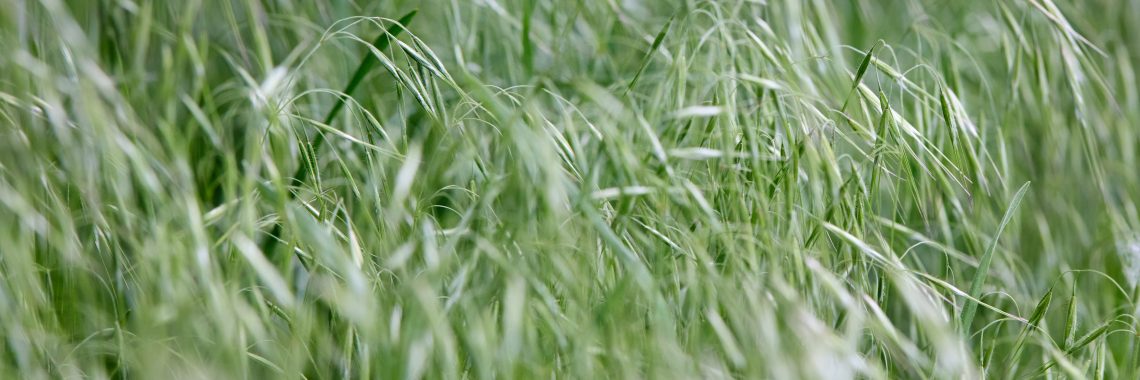It’s just grass and it grows anywhere, right? Grass species are diverse, and certain conditions favor particular species. By answering the following questions, you can match your grass to your conditions and needs.
What is the purpose or management objective for the field?
Certain grass species perform better for certain applications. For instance, hay production typically requires grasses that produce a lot of erect vegetation with large (wide) leaves. These grasses are typically non-native species, such as smooth brome. Grazing systems can include the same types of grass species as hay production and also include primarily species with have basal leaves, such as a bluegrass. Both native and non-native species are available for these applications.
What about soil, water?
Soil type and quality narrow your choices further, as these characteristics greatly influence how well grass species perform. Soil type is categorized by the amount of sand, silt and clay soil contains. For instance, loams (clay loam, sandy loam, loam, sandy clay loam) are generally considered the happy medium of soils, with the deep, dark, rich loams being the most desirable. These typically benefit a majority of the grass species.
On the other hand, fewer species are able to perform in the extreme types of soil, such as heavy clay, sand and silt. Soil quality, which includes pH and salinity, also contributes to the effect of the soil on grass species.
The last factor that affects a grass species is the availability of water, whether as precipitation, irrigation or both. This gives rise to the following questions:
- Is the water supply unlimited?
- How much precipitation does the field receive during the growing season?
- When is the water available?
- Does water stand in the field for extended periods?
- Does the ground stay moist between irrigation and rain events, or does it dry out?
- Selecting suitable grass species is easier if you match the grass to the moisture. For example, intermediate wheatgrass does not perform well in a field with a high water table or standing water, whereas timothy would thrive. Soil type also influences availability of water. For example, a clay soil typically absorbs water more slowly and retains water longer than a sandy soil.
Decision Time
Once you identify the conditions in the pasture or hayfield and your purpose or management objectives, consider species that fit the criteria you determined. You can also contact your local UW Extension educator or discuss your needs with seed companies before purchasing seed.
10 grass species For Wyoming conditions
- Creeping Foxtail. A long-lived, cool-season grass that does best on poorly drained soils. It can withstand 35 inches of standing water for 45 days without injury. Adapted for a wide variety of soils, especially sand, loam, clay and peat; also tolerates neutral to high pH soils. This grass is suited for pastures or hay production. Concerns for establishment are the small, week seedling and slow growth development. Can be invasive on native wetlands.
- Intermediate Wheatgrass. Cool-season, moderate sod-forming grass that does best on well-drained (sandy) soils. Moderately tolerant of alkaline soils (higher pH). Suited to limited or full irrigation.
- Meadow Brome (pictured). Long-lived grass that performs well with consistent and limited irrigation. Adapted to mildly alkaline soils, though sensitive to spring flooding. This grass can be used for hay or pasture and is recommended in mixtures only.
- NewHy Hybrid. Has a bunch growth habit and is best in pastures, though it can be used for hay production. Tolerates salinity and high pH soils, as well as soils with high water tables. Performs poorly in highly fertile soils and normal irrigation.
- Orchardgrass. Medium- to long-lived bunch grass adapted for well-drained soils. This plant needs consistent water and is grown for hay, pasture and, occasionally, silage. Sustains summer production well and is recommended in mixtures only.
- Perennial Ryegrass. Cool-season bunch grass primarily used for pastures. This is not a very vigorous species and should be planted in seed mixtures only or used as a cover crop. Requires consistent water but cannot tolerate standing water and performs poorly at temperatures above 80°F.
- Smooth Brome. Long-lived, aggressive, sod-forming grass. Best adapted for moist, well-drained soils but grows in a wide range of soil and moisture conditions. Tolerant of alkaline soils though not as tolerant of saline soils. Concerns are slow development to full production, aggressively outcompetes in a mix and recovers slowly when harvested.
- Tall Fescue. Long-lived, deep-rooted bunch grass that grows in a wide range of soils. Used for hay or pasture, it is adapted to irrigated and semi-irrigated pastures with high fertility. Performs poorly on sandy soils with long periods of drought. Plant endophyte-free varieties to avoid fungal problems with livestock.
- Tall Wheatgrass. Long-lived bunch grass that can tolerate soils too alkaline or saline for other crops. Performs well in irrigated, sub-irrigated fields or poorly drained, high pH soils. Produces fair quality hay and is a good pasture forage for difficult soil conditions. Concerns are seedlings slow to establish and does not tolerate drought conditions.
- Timothy. A widely grown forage suitable for wet, fertile soils. Can tolerate standing water but not dry, hot periods during the growing season. Can tolerate a wide variety of soils as long as adequate water is available. Typically harvested for hay; provides quality forage for pastures, though it does not tolerate heavy grazing.
Jeremiah Vardiman is an agriculture and horticulture educator in Powell. Contact him at (307) 754-8836 or jvardima@uwyo.edu.
Reprinted from Barnyards & Backyards 2017.





